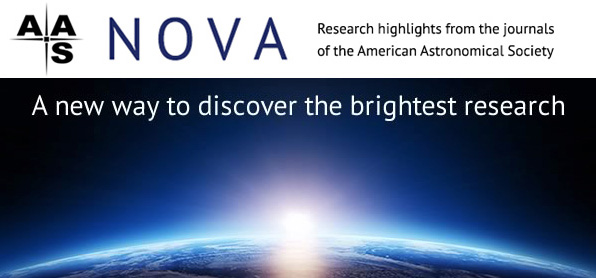Highlights from AAS Nova: 29 October - 11 November 2017

Susanna Kohler American Astronomical Society (AAS)
AAS Nova provides brief highlights of recently published articles from the AAS journals, i.e., The Astronomical Journal (AJ) and The Astrophysical Journal (ApJ), ApJ Letters, and ApJ Supplements. The website's intent is to gain broader exposure for AAS authors and to provide astronomy researchers and enthusiasts with summaries of recent, interesting research across a wide range of astronomical fields.
The following are the AAS Nova highlights from the past two weeks; follow the links to read more, or visit the AAS Nova webpage for more posts.
10 November 2017
Use Authorea or Overleaf to Submit to AAS Journals
Do you use collaborative document preparation software like Authorea or Overleaf? If so, submitting to AAS journals just got easier.
8 November 2017
Carrying Energy to the Corona with Waves
Why is the Sun’s atmosphere so much hotter than its surface? A new study explores the role of magnetic waves in heating the Sun’s corona.
7 November 2017
Feeding Black Holes Through Galactic Bars
Galactic bars channel gas into the central regions of spiral galaxies to birth new stars. Astrobites reports on whether they are also responsible for lighting up their black holes.
6 November 2017
Did Triton Destroy Neptune’s First Moons?
Neptune’s moon system is not what we would expect for a gas giant in our solar system — and its largest moon, Triton, may be to blame.
3 November 2017
Tracing the Fuel for Forming Stars
Only a small fraction of the cold hydrogen gas in the local universe is molecular gas, able to directly fuel star formation. But is this also true at earlier times in our universe?
1 November 2017
RNAAS: A Unique Journal Joins the Family
RNAAS is a new home for your brief science communications that are likely to be interesting or useful to members of the astronomical community.
31 October 2017
Modeling Limitless Skies
Astrobites reports on how we can better understand the signatures in exoplanet atmospheres — something that we can use in our search for life on other planets.
30 October 2017
Featured Image: Extinction in Our Inner Galaxy
Gas and dust can get in the way of our view of the Milky Way’s center! A new study uses tens of millions of stars to map this extinction.


